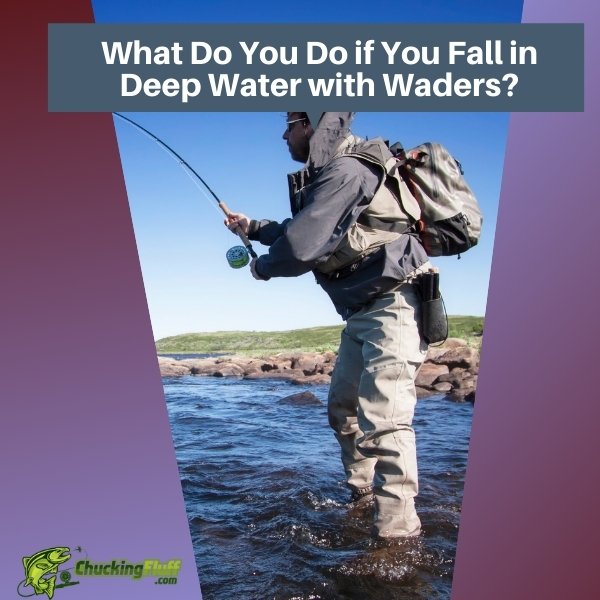| Disclosure: Just to be open and honest the buttons and links you click on in the website will in most cases take you to another website where you can purchase the products I am reviewing. As an Amazon Associate I earn from qualifying purchases. |
What Do You Do if You Fall in Deep Water with Waders?

Fishing waders are an essential gear for any angler who wants better access to more yielding waters because they increase the chances of catching more fish and in bigger sizes.
But amidst all angling tasks, small and big accidents could occur and the most typical is falls either from slipping because of poor traction on slippery surfaces or boat tumbles.
Imagine your active self on a kayak in the deepest parts of your local river and before you know it, the currents overpower your vessel and you are the biggest ‘fish’ that ever existed in that waterbody.
What do you do if you fall in deep water with waders?
It usually isn’t the first thing most anglers would do, but the starting point should be to stay calm and fight the water.
If anything, fight your instincts for you to stay alive longer when you fall in deep water.
Of course, the fall will be accidental and panic might get the better part of you and if you aren’t careful, this might worsen things.
Calm down and try floating backward like you are lying on a bed – this strategy doesn’t need you to have extensive swimming skills.
Avoid tightening your body while at it; let your muscles loose then flow with the current.
If you are confident enough, move your legs or hands, one at a time to prevent drowning when one arm is in action.
You want to save the rest to regain more energy for the sequence to continue until you are in a safer zone.
Quick Post Navigation
What Do You Do if You Fall in Deep Water with Waders?
Your response when you dunk in water with waders will vary depending on the depth.
Shallow to chest-high depths will need you to include a few steps like figuring out the type of ground you are stepping on which will be difficult if the same happens in deeper waters.
Let’s learn what you should do in case you fall in very deep water when wearing waders.
CALM DOWN!!!
I didn’t mean to be that bold and loud, but it is very vital to put this across as the first step if you fall in deep water when in waders.
Don’t let the panic period last long.
Yes, you will panic, but it is crucial to keep yourself together for you to execute the next safety steps.
Don’t try moving your arms in a bid to swim while panicking – you lose more energy in the process which can increase the chances of drowning in case the currents are stronger.
That is where fighting your instincts come in; avoid thrashing, gasping or swimming hard.
These are fast killers in this situation because water can easily enter your lungs, strain your heart, cool your skin instantly, then air begins escaping your waders reducing buoyancy.
Try Floating
Once you are calm, try floating even for a while.
In as much as it is a counter-intuitive action, the impacts of low temperature shock will pass pretty fast, within a minute or two.
Floating for a while allows you to regain your energy and breathing control.
And if you are unaware, this is the secret to greatly increasing your chances of surviving.
Floating in waders without a PFD isn’t easy in cold open waters but most people hack it because the air trapped in the fishing gear during the fall makes things easier.
The Backward Strategy
Lifeguards recommend laying afloat on your back.
The position helps to keep your airway clear and calm you so that you can focus on controllable breathing as you call for help.
Try filling your lungs with more air to aid floatation with shallow breaths from time to time.
If you are holding any tackle, drop them as they could be weighing you down.
More so, your life is more important at this point than what you are holding.
Use your legs to kick lightly (you want to save as much energy as possible).
The kicks and arm movements should help you slowly maneuver the water to shallow depths.
The backward position will let water into your ears which might be uncomfortable.
Tilt you head back to ensure you remain in a floatable state.
If you fall in the ocean, the task can be more difficult, however, aligning yourself for the waver to come from behind you is ideal.
The waves will push you to the shores.
What Do You Do if You Fall in Deep Water With Waders? – FAQs
Sounds scary but anglers who follow these simple steps hardly find themselves at much risk.
Here are more QNAs to help you stay safe in case you dunk when in waders.
Q) What Can I Do to Increase My Chances of Floating in Deep Water?
A) Always wear the right type of PFD if you will be wet wading or boat fishing in deeper waters.
The same applies to anglers who fish from steep cliffs in winter – these could have slippery grounds and you risk falling in water if you lose balance.
Q) Does Water Fill Waders If One Falls in Water?
A) Water will rush into your underneath layers and drench them and seep through your waders from the inner side.
However, the air that rushes in the waders before filling with water allows you to float and with the help of the steps above, you can slowly maneuver to safety.
Q) How Can I Prevent Falling in Water When in Waders?
A) Check where you are fishing from and ensure the surface isn’t slippery to avoid slipping and dunking in water.
If you intend to go boat fishing, ensure your vessel’s condition is top-notch, so should the skills of the paddler.
You want to avoid boat fishing if the waterbody isn’t calm.
Wrap Up
What do you do if you fall in deep water with waders?
Calm down and avoid swimming hard.
You want to try floating as much as possible because this allows the cold water shock to pass quickly.
Once you beat this, the last step is taking the back position to clear your airway.
You want to control your breathing while letting in as much air into your lungs as possible with shallow breaths to help with buoyancy.
Use your limbs, one at a time to move backward while tilting your head back.
The position allows you to be calmer, use less energy to move to safety, and call for help.



